E-Commerce Business Models and Applications for Ballarat Trade Fair Consultancy (BTFC)
VerifiedAdded on 2023/06/04
|12
|2737
|104
AI Summary
This article discusses the e-commerce business models and applications that can be implemented for Ballarat Trade Fair Consultancy (BTFC) to enhance its marketing campaigns and activities. It addresses security, privacy, and legal issues that may arise. The proposed system interface and measurement of success are also discussed.
Contribute Materials
Your contribution can guide someone’s learning journey. Share your
documents today.

qwertyuiopasdfghjklzxcvbnmqwert
yuiopasdfghjklzxcvbnmqwertyuiop
asdfghjklzxcvbnmqwertyuiopasdfg
hjklzxcvbnmqwertyuiopasdfghjklzx
cvbnmqwertyuiopasdfghjklzxcvbn
mqwertyuiopasdfghjklzxcvbnmqwe
rtyuiopasdfghjklzxcvbnmqwertyui
opasdfghjklzxcvbnmqwertyuiopasd
fghjklzxcvbnmqwertyuiopasdfghjkl
zxcvbnmqwertyuiopasdfghjklzxcvb
nmqwertyuiopasdfghjklzxcvbnmq
wertyuiopasdfghjklzxcvbnmqwerty
uiopasdfghjklzxcvbnmqwertyuiopa
sdfghjklzxcvbnmqwertyuiopasdfgh
jklzxcvbnmqwertyuiopasdfghjklzxc
vbnmrtyuiopasdfghjklzxcvbnmqwe
rtyuiopasdfghjklzxcvbnmqwertyui
Ballarat Trade Fair Consultancy (BTFC)
Event Management: E-Commerce
10/9/2018
yuiopasdfghjklzxcvbnmqwertyuiop
asdfghjklzxcvbnmqwertyuiopasdfg
hjklzxcvbnmqwertyuiopasdfghjklzx
cvbnmqwertyuiopasdfghjklzxcvbn
mqwertyuiopasdfghjklzxcvbnmqwe
rtyuiopasdfghjklzxcvbnmqwertyui
opasdfghjklzxcvbnmqwertyuiopasd
fghjklzxcvbnmqwertyuiopasdfghjkl
zxcvbnmqwertyuiopasdfghjklzxcvb
nmqwertyuiopasdfghjklzxcvbnmq
wertyuiopasdfghjklzxcvbnmqwerty
uiopasdfghjklzxcvbnmqwertyuiopa
sdfghjklzxcvbnmqwertyuiopasdfgh
jklzxcvbnmqwertyuiopasdfghjklzxc
vbnmrtyuiopasdfghjklzxcvbnmqwe
rtyuiopasdfghjklzxcvbnmqwertyui
Ballarat Trade Fair Consultancy (BTFC)
Event Management: E-Commerce
10/9/2018
Secure Best Marks with AI Grader
Need help grading? Try our AI Grader for instant feedback on your assignments.
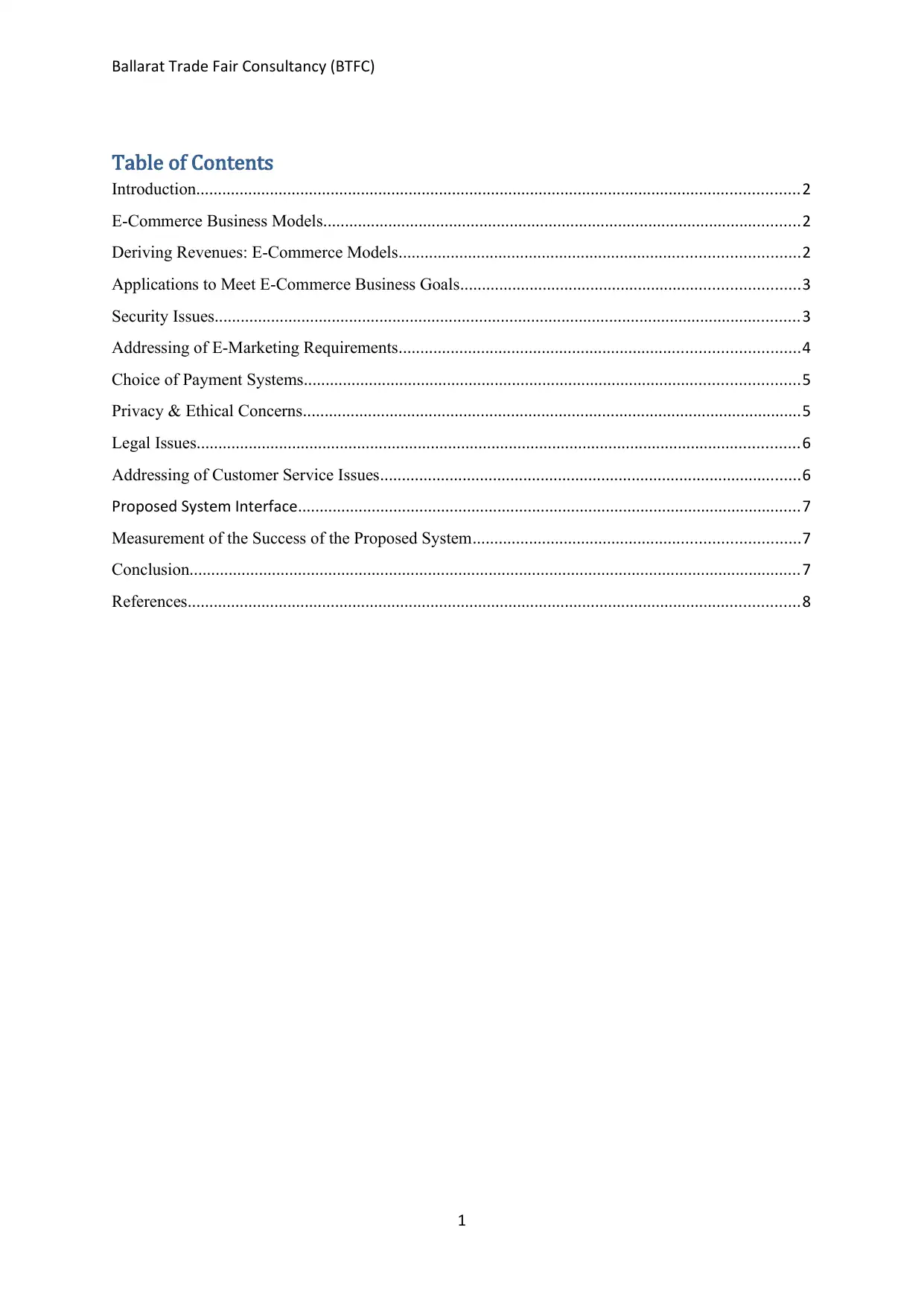
Ballarat Trade Fair Consultancy (BTFC)
Table of Contents
Introduction...........................................................................................................................................2
E-Commerce Business Models..............................................................................................................2
Deriving Revenues: E-Commerce Models............................................................................................2
Applications to Meet E-Commerce Business Goals..............................................................................3
Security Issues.......................................................................................................................................3
Addressing of E-Marketing Requirements............................................................................................4
Choice of Payment Systems..................................................................................................................5
Privacy & Ethical Concerns...................................................................................................................5
Legal Issues...........................................................................................................................................6
Addressing of Customer Service Issues.................................................................................................6
Proposed System Interface....................................................................................................................7
Measurement of the Success of the Proposed System...........................................................................7
Conclusion.............................................................................................................................................7
References.............................................................................................................................................8
1
Table of Contents
Introduction...........................................................................................................................................2
E-Commerce Business Models..............................................................................................................2
Deriving Revenues: E-Commerce Models............................................................................................2
Applications to Meet E-Commerce Business Goals..............................................................................3
Security Issues.......................................................................................................................................3
Addressing of E-Marketing Requirements............................................................................................4
Choice of Payment Systems..................................................................................................................5
Privacy & Ethical Concerns...................................................................................................................5
Legal Issues...........................................................................................................................................6
Addressing of Customer Service Issues.................................................................................................6
Proposed System Interface....................................................................................................................7
Measurement of the Success of the Proposed System...........................................................................7
Conclusion.............................................................................................................................................7
References.............................................................................................................................................8
1
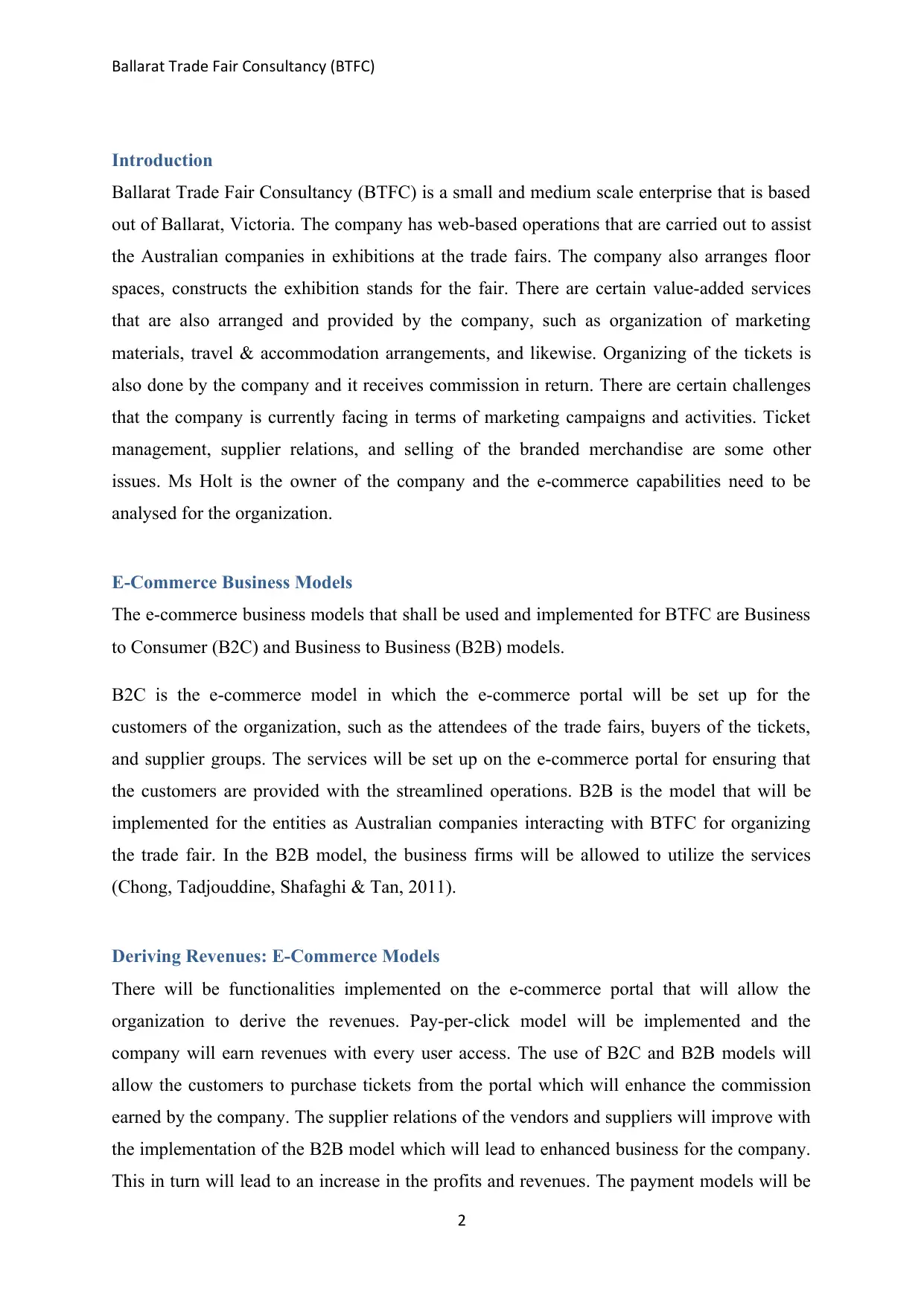
Ballarat Trade Fair Consultancy (BTFC)
Introduction
Ballarat Trade Fair Consultancy (BTFC) is a small and medium scale enterprise that is based
out of Ballarat, Victoria. The company has web-based operations that are carried out to assist
the Australian companies in exhibitions at the trade fairs. The company also arranges floor
spaces, constructs the exhibition stands for the fair. There are certain value-added services
that are also arranged and provided by the company, such as organization of marketing
materials, travel & accommodation arrangements, and likewise. Organizing of the tickets is
also done by the company and it receives commission in return. There are certain challenges
that the company is currently facing in terms of marketing campaigns and activities. Ticket
management, supplier relations, and selling of the branded merchandise are some other
issues. Ms Holt is the owner of the company and the e-commerce capabilities need to be
analysed for the organization.
E-Commerce Business Models
The e-commerce business models that shall be used and implemented for BTFC are Business
to Consumer (B2C) and Business to Business (B2B) models.
B2C is the e-commerce model in which the e-commerce portal will be set up for the
customers of the organization, such as the attendees of the trade fairs, buyers of the tickets,
and supplier groups. The services will be set up on the e-commerce portal for ensuring that
the customers are provided with the streamlined operations. B2B is the model that will be
implemented for the entities as Australian companies interacting with BTFC for organizing
the trade fair. In the B2B model, the business firms will be allowed to utilize the services
(Chong, Tadjouddine, Shafaghi & Tan, 2011).
Deriving Revenues: E-Commerce Models
There will be functionalities implemented on the e-commerce portal that will allow the
organization to derive the revenues. Pay-per-click model will be implemented and the
company will earn revenues with every user access. The use of B2C and B2B models will
allow the customers to purchase tickets from the portal which will enhance the commission
earned by the company. The supplier relations of the vendors and suppliers will improve with
the implementation of the B2B model which will lead to enhanced business for the company.
This in turn will lead to an increase in the profits and revenues. The payment models will be
2
Introduction
Ballarat Trade Fair Consultancy (BTFC) is a small and medium scale enterprise that is based
out of Ballarat, Victoria. The company has web-based operations that are carried out to assist
the Australian companies in exhibitions at the trade fairs. The company also arranges floor
spaces, constructs the exhibition stands for the fair. There are certain value-added services
that are also arranged and provided by the company, such as organization of marketing
materials, travel & accommodation arrangements, and likewise. Organizing of the tickets is
also done by the company and it receives commission in return. There are certain challenges
that the company is currently facing in terms of marketing campaigns and activities. Ticket
management, supplier relations, and selling of the branded merchandise are some other
issues. Ms Holt is the owner of the company and the e-commerce capabilities need to be
analysed for the organization.
E-Commerce Business Models
The e-commerce business models that shall be used and implemented for BTFC are Business
to Consumer (B2C) and Business to Business (B2B) models.
B2C is the e-commerce model in which the e-commerce portal will be set up for the
customers of the organization, such as the attendees of the trade fairs, buyers of the tickets,
and supplier groups. The services will be set up on the e-commerce portal for ensuring that
the customers are provided with the streamlined operations. B2B is the model that will be
implemented for the entities as Australian companies interacting with BTFC for organizing
the trade fair. In the B2B model, the business firms will be allowed to utilize the services
(Chong, Tadjouddine, Shafaghi & Tan, 2011).
Deriving Revenues: E-Commerce Models
There will be functionalities implemented on the e-commerce portal that will allow the
organization to derive the revenues. Pay-per-click model will be implemented and the
company will earn revenues with every user access. The use of B2C and B2B models will
allow the customers to purchase tickets from the portal which will enhance the commission
earned by the company. The supplier relations of the vendors and suppliers will improve with
the implementation of the B2B model which will lead to enhanced business for the company.
This in turn will lead to an increase in the profits and revenues. The payment models will be
2
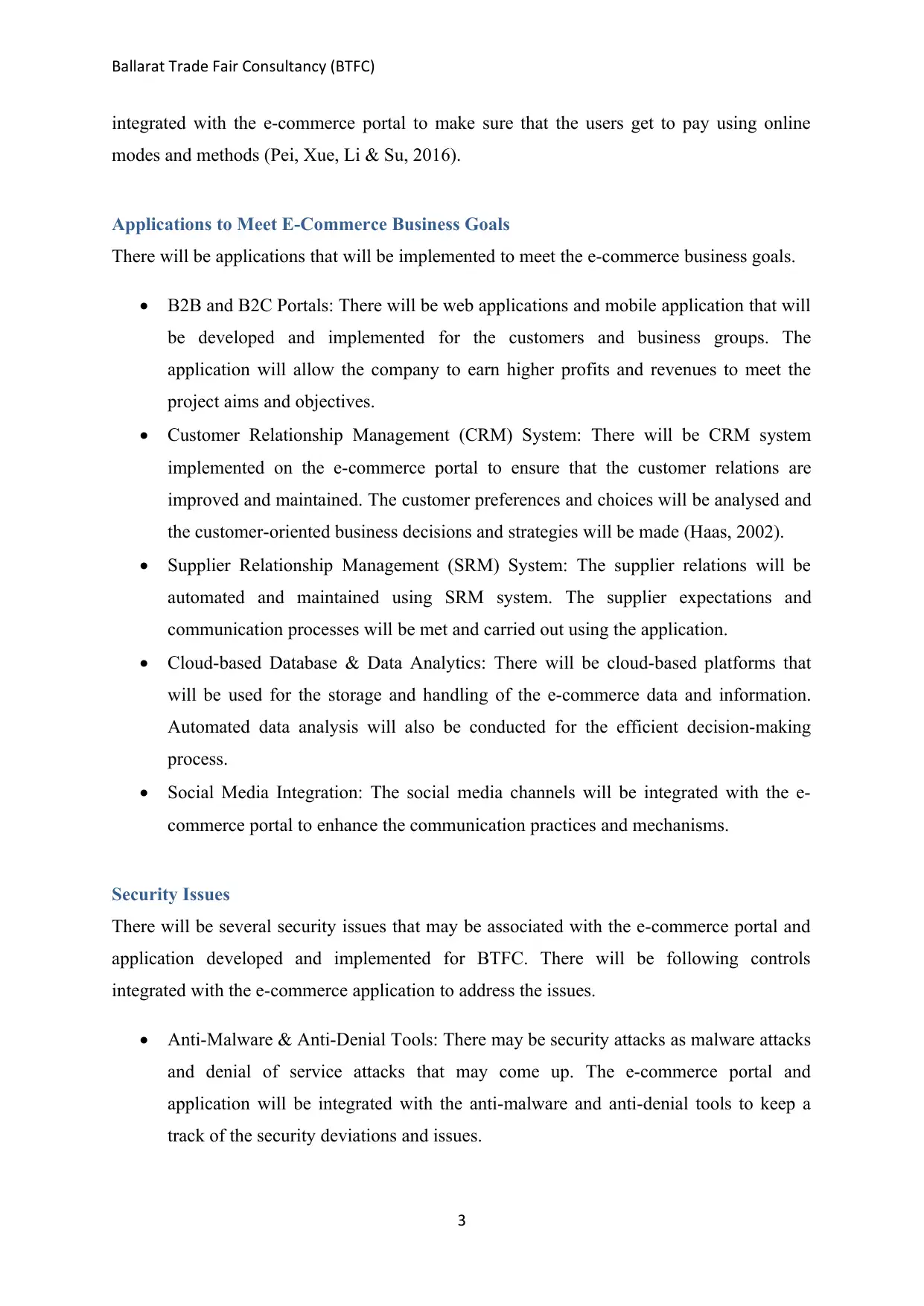
Ballarat Trade Fair Consultancy (BTFC)
integrated with the e-commerce portal to make sure that the users get to pay using online
modes and methods (Pei, Xue, Li & Su, 2016).
Applications to Meet E-Commerce Business Goals
There will be applications that will be implemented to meet the e-commerce business goals.
B2B and B2C Portals: There will be web applications and mobile application that will
be developed and implemented for the customers and business groups. The
application will allow the company to earn higher profits and revenues to meet the
project aims and objectives.
Customer Relationship Management (CRM) System: There will be CRM system
implemented on the e-commerce portal to ensure that the customer relations are
improved and maintained. The customer preferences and choices will be analysed and
the customer-oriented business decisions and strategies will be made (Haas, 2002).
Supplier Relationship Management (SRM) System: The supplier relations will be
automated and maintained using SRM system. The supplier expectations and
communication processes will be met and carried out using the application.
Cloud-based Database & Data Analytics: There will be cloud-based platforms that
will be used for the storage and handling of the e-commerce data and information.
Automated data analysis will also be conducted for the efficient decision-making
process.
Social Media Integration: The social media channels will be integrated with the e-
commerce portal to enhance the communication practices and mechanisms.
Security Issues
There will be several security issues that may be associated with the e-commerce portal and
application developed and implemented for BTFC. There will be following controls
integrated with the e-commerce application to address the issues.
Anti-Malware & Anti-Denial Tools: There may be security attacks as malware attacks
and denial of service attacks that may come up. The e-commerce portal and
application will be integrated with the anti-malware and anti-denial tools to keep a
track of the security deviations and issues.
3
integrated with the e-commerce portal to make sure that the users get to pay using online
modes and methods (Pei, Xue, Li & Su, 2016).
Applications to Meet E-Commerce Business Goals
There will be applications that will be implemented to meet the e-commerce business goals.
B2B and B2C Portals: There will be web applications and mobile application that will
be developed and implemented for the customers and business groups. The
application will allow the company to earn higher profits and revenues to meet the
project aims and objectives.
Customer Relationship Management (CRM) System: There will be CRM system
implemented on the e-commerce portal to ensure that the customer relations are
improved and maintained. The customer preferences and choices will be analysed and
the customer-oriented business decisions and strategies will be made (Haas, 2002).
Supplier Relationship Management (SRM) System: The supplier relations will be
automated and maintained using SRM system. The supplier expectations and
communication processes will be met and carried out using the application.
Cloud-based Database & Data Analytics: There will be cloud-based platforms that
will be used for the storage and handling of the e-commerce data and information.
Automated data analysis will also be conducted for the efficient decision-making
process.
Social Media Integration: The social media channels will be integrated with the e-
commerce portal to enhance the communication practices and mechanisms.
Security Issues
There will be several security issues that may be associated with the e-commerce portal and
application developed and implemented for BTFC. There will be following controls
integrated with the e-commerce application to address the issues.
Anti-Malware & Anti-Denial Tools: There may be security attacks as malware attacks
and denial of service attacks that may come up. The e-commerce portal and
application will be integrated with the anti-malware and anti-denial tools to keep a
track of the security deviations and issues.
3
Secure Best Marks with AI Grader
Need help grading? Try our AI Grader for instant feedback on your assignments.
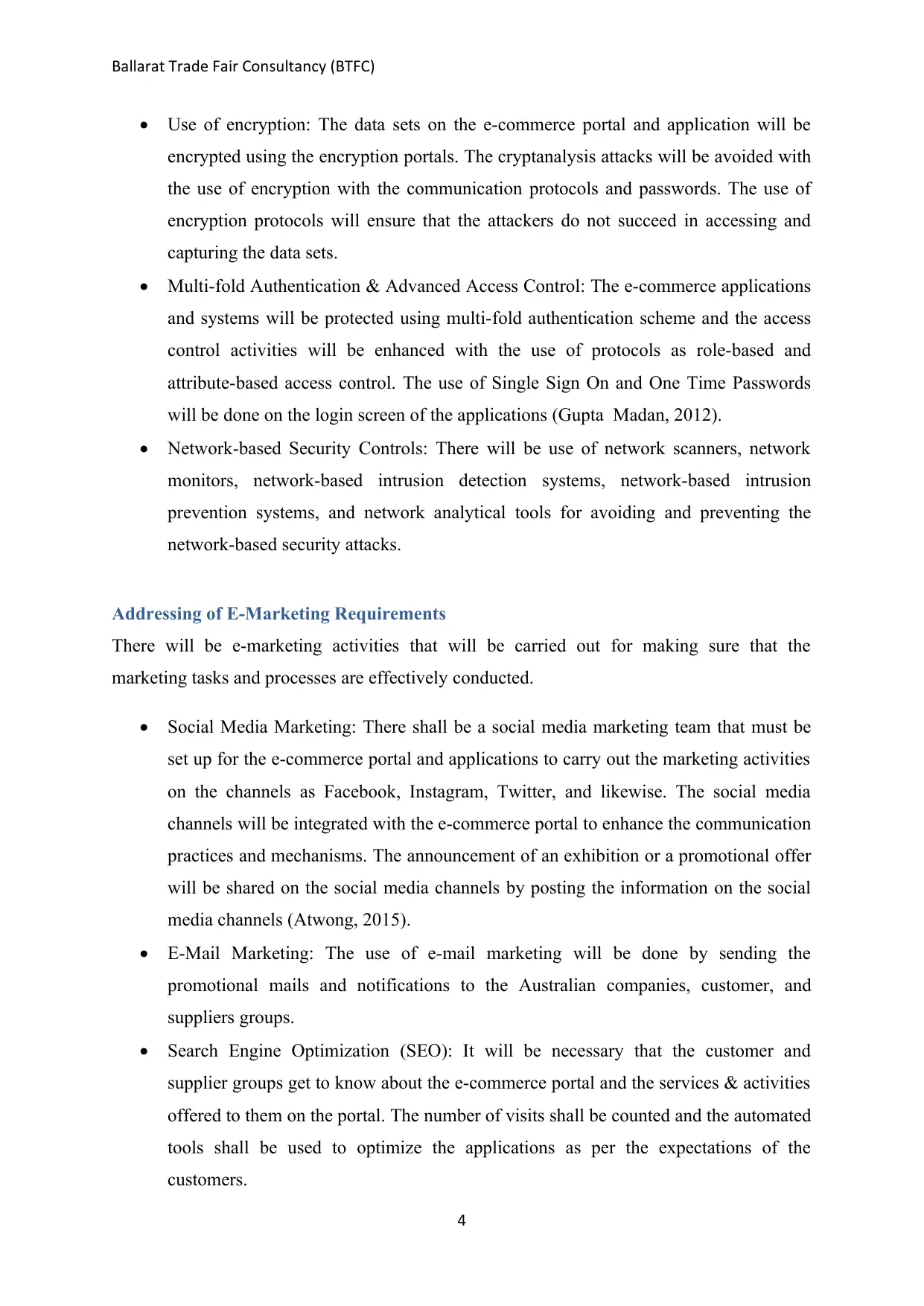
Ballarat Trade Fair Consultancy (BTFC)
Use of encryption: The data sets on the e-commerce portal and application will be
encrypted using the encryption portals. The cryptanalysis attacks will be avoided with
the use of encryption with the communication protocols and passwords. The use of
encryption protocols will ensure that the attackers do not succeed in accessing and
capturing the data sets.
Multi-fold Authentication & Advanced Access Control: The e-commerce applications
and systems will be protected using multi-fold authentication scheme and the access
control activities will be enhanced with the use of protocols as role-based and
attribute-based access control. The use of Single Sign On and One Time Passwords
will be done on the login screen of the applications (Gupta Madan, 2012).
Network-based Security Controls: There will be use of network scanners, network
monitors, network-based intrusion detection systems, network-based intrusion
prevention systems, and network analytical tools for avoiding and preventing the
network-based security attacks.
Addressing of E-Marketing Requirements
There will be e-marketing activities that will be carried out for making sure that the
marketing tasks and processes are effectively conducted.
Social Media Marketing: There shall be a social media marketing team that must be
set up for the e-commerce portal and applications to carry out the marketing activities
on the channels as Facebook, Instagram, Twitter, and likewise. The social media
channels will be integrated with the e-commerce portal to enhance the communication
practices and mechanisms. The announcement of an exhibition or a promotional offer
will be shared on the social media channels by posting the information on the social
media channels (Atwong, 2015).
E-Mail Marketing: The use of e-mail marketing will be done by sending the
promotional mails and notifications to the Australian companies, customer, and
suppliers groups.
Search Engine Optimization (SEO): It will be necessary that the customer and
supplier groups get to know about the e-commerce portal and the services & activities
offered to them on the portal. The number of visits shall be counted and the automated
tools shall be used to optimize the applications as per the expectations of the
customers.
4
Use of encryption: The data sets on the e-commerce portal and application will be
encrypted using the encryption portals. The cryptanalysis attacks will be avoided with
the use of encryption with the communication protocols and passwords. The use of
encryption protocols will ensure that the attackers do not succeed in accessing and
capturing the data sets.
Multi-fold Authentication & Advanced Access Control: The e-commerce applications
and systems will be protected using multi-fold authentication scheme and the access
control activities will be enhanced with the use of protocols as role-based and
attribute-based access control. The use of Single Sign On and One Time Passwords
will be done on the login screen of the applications (Gupta Madan, 2012).
Network-based Security Controls: There will be use of network scanners, network
monitors, network-based intrusion detection systems, network-based intrusion
prevention systems, and network analytical tools for avoiding and preventing the
network-based security attacks.
Addressing of E-Marketing Requirements
There will be e-marketing activities that will be carried out for making sure that the
marketing tasks and processes are effectively conducted.
Social Media Marketing: There shall be a social media marketing team that must be
set up for the e-commerce portal and applications to carry out the marketing activities
on the channels as Facebook, Instagram, Twitter, and likewise. The social media
channels will be integrated with the e-commerce portal to enhance the communication
practices and mechanisms. The announcement of an exhibition or a promotional offer
will be shared on the social media channels by posting the information on the social
media channels (Atwong, 2015).
E-Mail Marketing: The use of e-mail marketing will be done by sending the
promotional mails and notifications to the Australian companies, customer, and
suppliers groups.
Search Engine Optimization (SEO): It will be necessary that the customer and
supplier groups get to know about the e-commerce portal and the services & activities
offered to them on the portal. The number of visits shall be counted and the automated
tools shall be used to optimize the applications as per the expectations of the
customers.
4

Ballarat Trade Fair Consultancy (BTFC)
Content Marketing: The Company may use different forms of content marketing
activities using the press release, posting the content on the social media platforms,
and other methods.
The use of these e-marketing activities will allow the company to reach out to increased
number of users and customers.
Choice of Payment Systems
There are a variety of payment systems that shall be used and integrated on the e-commerce
portal. These payments systems include the use of credit or debit cards. These cards shall be
used to allow the users to pay online for the services that they acquire. The price for the
tickets or the commission to the company will be made by the Australian companies and
customers using their debit or credit cards.
There are several e-wallets that shall be integrated on the portal and the users shall be
provided with the ability to make payments using these wallets. The customers may already
have balance in their e-wallets which may be used to make the payments (Ying & Kuanhai,
2011).
The use of net banking shall also be allowed and provided as a method of payment. The use
of the net banking method will allow the users to make payments for the services and tickets
that they use and access from the portal.
Privacy & Ethical Concerns
There may be various privacy and ethical concerns that may come up for the customers and
the organizations. The privacy concerns may be in the form of data breaches, data leakage
issues, data manipulation issues, malware attacks, denial of service attacks, eavesdropping
attacks, and likewise. The privacy and confidentiality of the data sets will be impacted as a
result and it may have ethical implications as well. This is because the users and
administrators of the e-commerce portal may pass on the information to the unauthorized
entities.
The e-commerce portal and application shall be integrated with the anti-malware and anti-
denial tools to keep a track of the privacy deviations and issues. The data sets on the e-
commerce portal and application shall be encrypted using the encryption portals. The
5
Content Marketing: The Company may use different forms of content marketing
activities using the press release, posting the content on the social media platforms,
and other methods.
The use of these e-marketing activities will allow the company to reach out to increased
number of users and customers.
Choice of Payment Systems
There are a variety of payment systems that shall be used and integrated on the e-commerce
portal. These payments systems include the use of credit or debit cards. These cards shall be
used to allow the users to pay online for the services that they acquire. The price for the
tickets or the commission to the company will be made by the Australian companies and
customers using their debit or credit cards.
There are several e-wallets that shall be integrated on the portal and the users shall be
provided with the ability to make payments using these wallets. The customers may already
have balance in their e-wallets which may be used to make the payments (Ying & Kuanhai,
2011).
The use of net banking shall also be allowed and provided as a method of payment. The use
of the net banking method will allow the users to make payments for the services and tickets
that they use and access from the portal.
Privacy & Ethical Concerns
There may be various privacy and ethical concerns that may come up for the customers and
the organizations. The privacy concerns may be in the form of data breaches, data leakage
issues, data manipulation issues, malware attacks, denial of service attacks, eavesdropping
attacks, and likewise. The privacy and confidentiality of the data sets will be impacted as a
result and it may have ethical implications as well. This is because the users and
administrators of the e-commerce portal may pass on the information to the unauthorized
entities.
The e-commerce portal and application shall be integrated with the anti-malware and anti-
denial tools to keep a track of the privacy deviations and issues. The data sets on the e-
commerce portal and application shall be encrypted using the encryption portals. The
5
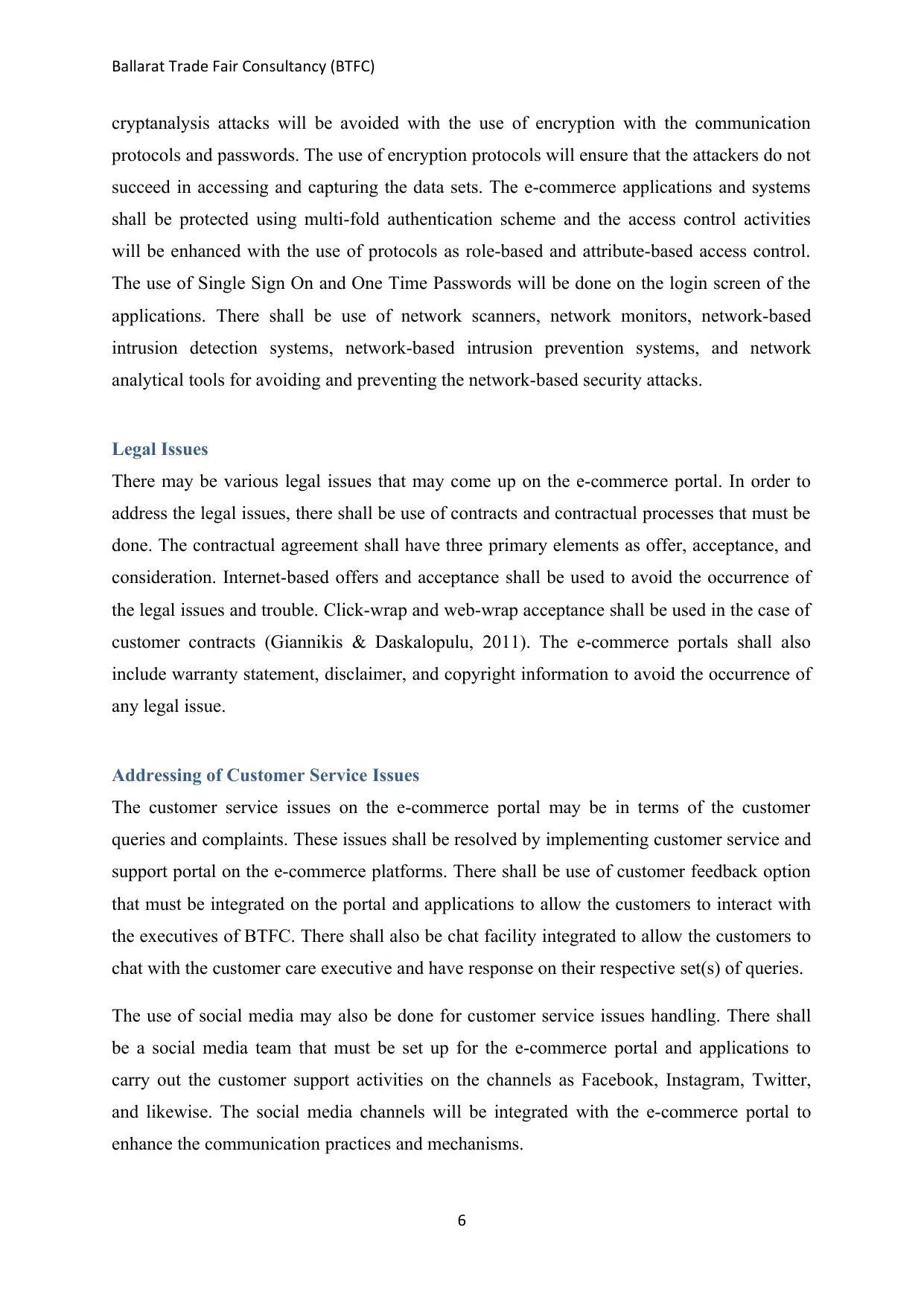
Ballarat Trade Fair Consultancy (BTFC)
cryptanalysis attacks will be avoided with the use of encryption with the communication
protocols and passwords. The use of encryption protocols will ensure that the attackers do not
succeed in accessing and capturing the data sets. The e-commerce applications and systems
shall be protected using multi-fold authentication scheme and the access control activities
will be enhanced with the use of protocols as role-based and attribute-based access control.
The use of Single Sign On and One Time Passwords will be done on the login screen of the
applications. There shall be use of network scanners, network monitors, network-based
intrusion detection systems, network-based intrusion prevention systems, and network
analytical tools for avoiding and preventing the network-based security attacks.
Legal Issues
There may be various legal issues that may come up on the e-commerce portal. In order to
address the legal issues, there shall be use of contracts and contractual processes that must be
done. The contractual agreement shall have three primary elements as offer, acceptance, and
consideration. Internet-based offers and acceptance shall be used to avoid the occurrence of
the legal issues and trouble. Click-wrap and web-wrap acceptance shall be used in the case of
customer contracts (Giannikis & Daskalopulu, 2011). The e-commerce portals shall also
include warranty statement, disclaimer, and copyright information to avoid the occurrence of
any legal issue.
Addressing of Customer Service Issues
The customer service issues on the e-commerce portal may be in terms of the customer
queries and complaints. These issues shall be resolved by implementing customer service and
support portal on the e-commerce platforms. There shall be use of customer feedback option
that must be integrated on the portal and applications to allow the customers to interact with
the executives of BTFC. There shall also be chat facility integrated to allow the customers to
chat with the customer care executive and have response on their respective set(s) of queries.
The use of social media may also be done for customer service issues handling. There shall
be a social media team that must be set up for the e-commerce portal and applications to
carry out the customer support activities on the channels as Facebook, Instagram, Twitter,
and likewise. The social media channels will be integrated with the e-commerce portal to
enhance the communication practices and mechanisms.
6
cryptanalysis attacks will be avoided with the use of encryption with the communication
protocols and passwords. The use of encryption protocols will ensure that the attackers do not
succeed in accessing and capturing the data sets. The e-commerce applications and systems
shall be protected using multi-fold authentication scheme and the access control activities
will be enhanced with the use of protocols as role-based and attribute-based access control.
The use of Single Sign On and One Time Passwords will be done on the login screen of the
applications. There shall be use of network scanners, network monitors, network-based
intrusion detection systems, network-based intrusion prevention systems, and network
analytical tools for avoiding and preventing the network-based security attacks.
Legal Issues
There may be various legal issues that may come up on the e-commerce portal. In order to
address the legal issues, there shall be use of contracts and contractual processes that must be
done. The contractual agreement shall have three primary elements as offer, acceptance, and
consideration. Internet-based offers and acceptance shall be used to avoid the occurrence of
the legal issues and trouble. Click-wrap and web-wrap acceptance shall be used in the case of
customer contracts (Giannikis & Daskalopulu, 2011). The e-commerce portals shall also
include warranty statement, disclaimer, and copyright information to avoid the occurrence of
any legal issue.
Addressing of Customer Service Issues
The customer service issues on the e-commerce portal may be in terms of the customer
queries and complaints. These issues shall be resolved by implementing customer service and
support portal on the e-commerce platforms. There shall be use of customer feedback option
that must be integrated on the portal and applications to allow the customers to interact with
the executives of BTFC. There shall also be chat facility integrated to allow the customers to
chat with the customer care executive and have response on their respective set(s) of queries.
The use of social media may also be done for customer service issues handling. There shall
be a social media team that must be set up for the e-commerce portal and applications to
carry out the customer support activities on the channels as Facebook, Instagram, Twitter,
and likewise. The social media channels will be integrated with the e-commerce portal to
enhance the communication practices and mechanisms.
6
Paraphrase This Document
Need a fresh take? Get an instant paraphrase of this document with our AI Paraphraser

Ballarat Trade Fair Consultancy (BTFC)
Proposed System Interface
Main page
7
Proposed System Interface
Main page
7
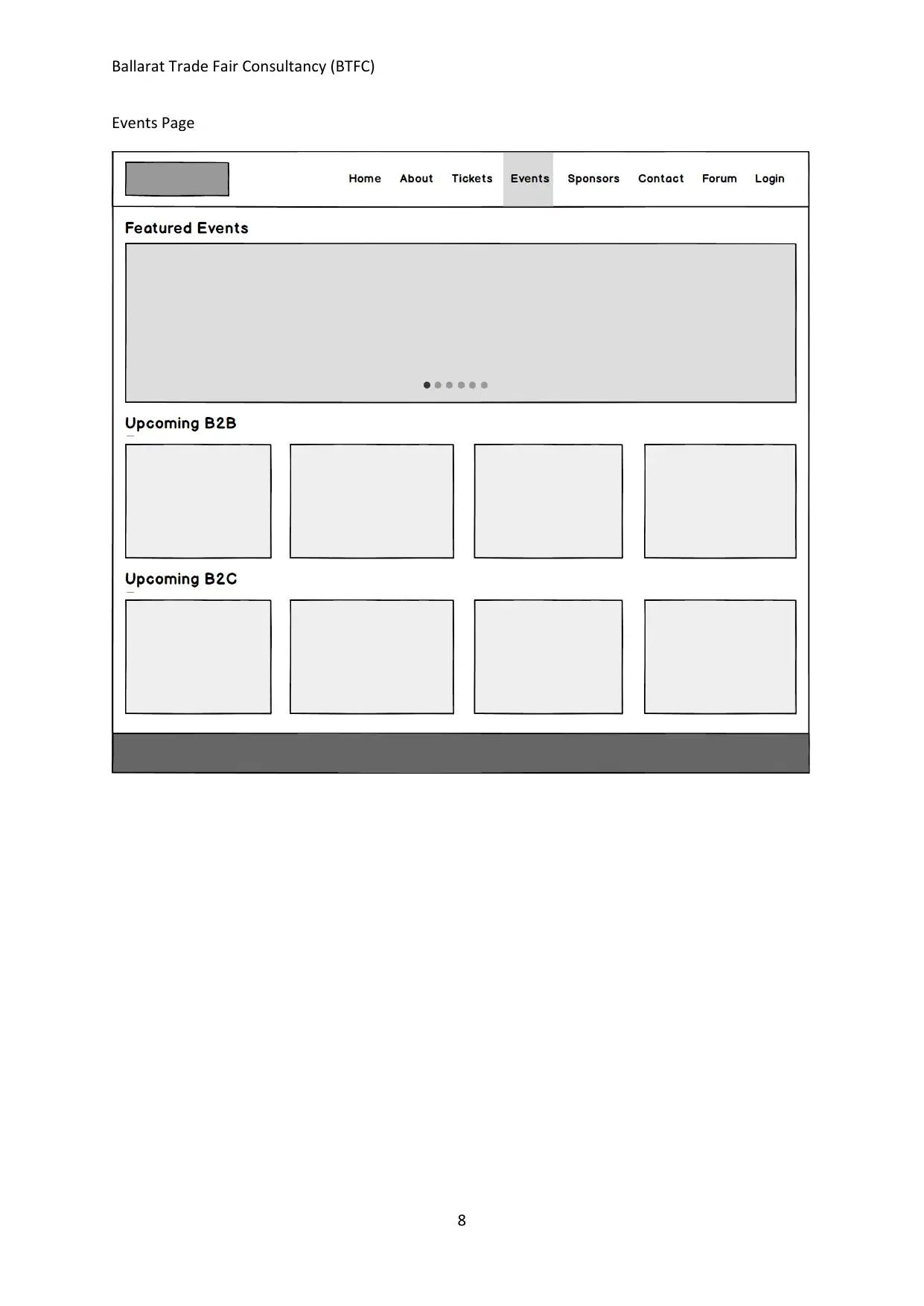
Ballarat Trade Fair Consultancy (BTFC)
Events Page
8
Events Page
8
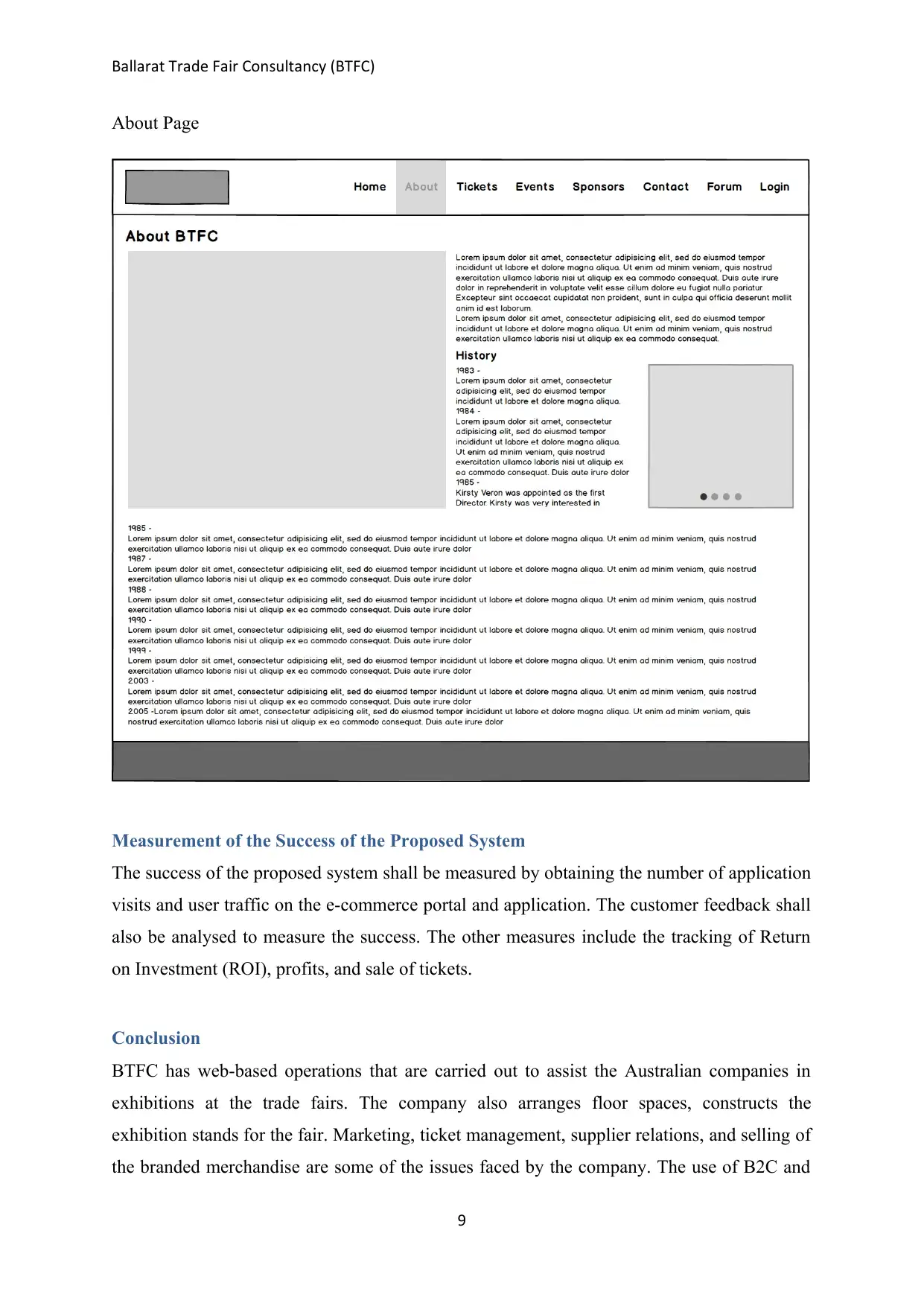
Ballarat Trade Fair Consultancy (BTFC)
About Page
Measurement of the Success of the Proposed System
The success of the proposed system shall be measured by obtaining the number of application
visits and user traffic on the e-commerce portal and application. The customer feedback shall
also be analysed to measure the success. The other measures include the tracking of Return
on Investment (ROI), profits, and sale of tickets.
Conclusion
BTFC has web-based operations that are carried out to assist the Australian companies in
exhibitions at the trade fairs. The company also arranges floor spaces, constructs the
exhibition stands for the fair. Marketing, ticket management, supplier relations, and selling of
the branded merchandise are some of the issues faced by the company. The use of B2C and
9
About Page
Measurement of the Success of the Proposed System
The success of the proposed system shall be measured by obtaining the number of application
visits and user traffic on the e-commerce portal and application. The customer feedback shall
also be analysed to measure the success. The other measures include the tracking of Return
on Investment (ROI), profits, and sale of tickets.
Conclusion
BTFC has web-based operations that are carried out to assist the Australian companies in
exhibitions at the trade fairs. The company also arranges floor spaces, constructs the
exhibition stands for the fair. Marketing, ticket management, supplier relations, and selling of
the branded merchandise are some of the issues faced by the company. The use of B2C and
9
Secure Best Marks with AI Grader
Need help grading? Try our AI Grader for instant feedback on your assignments.
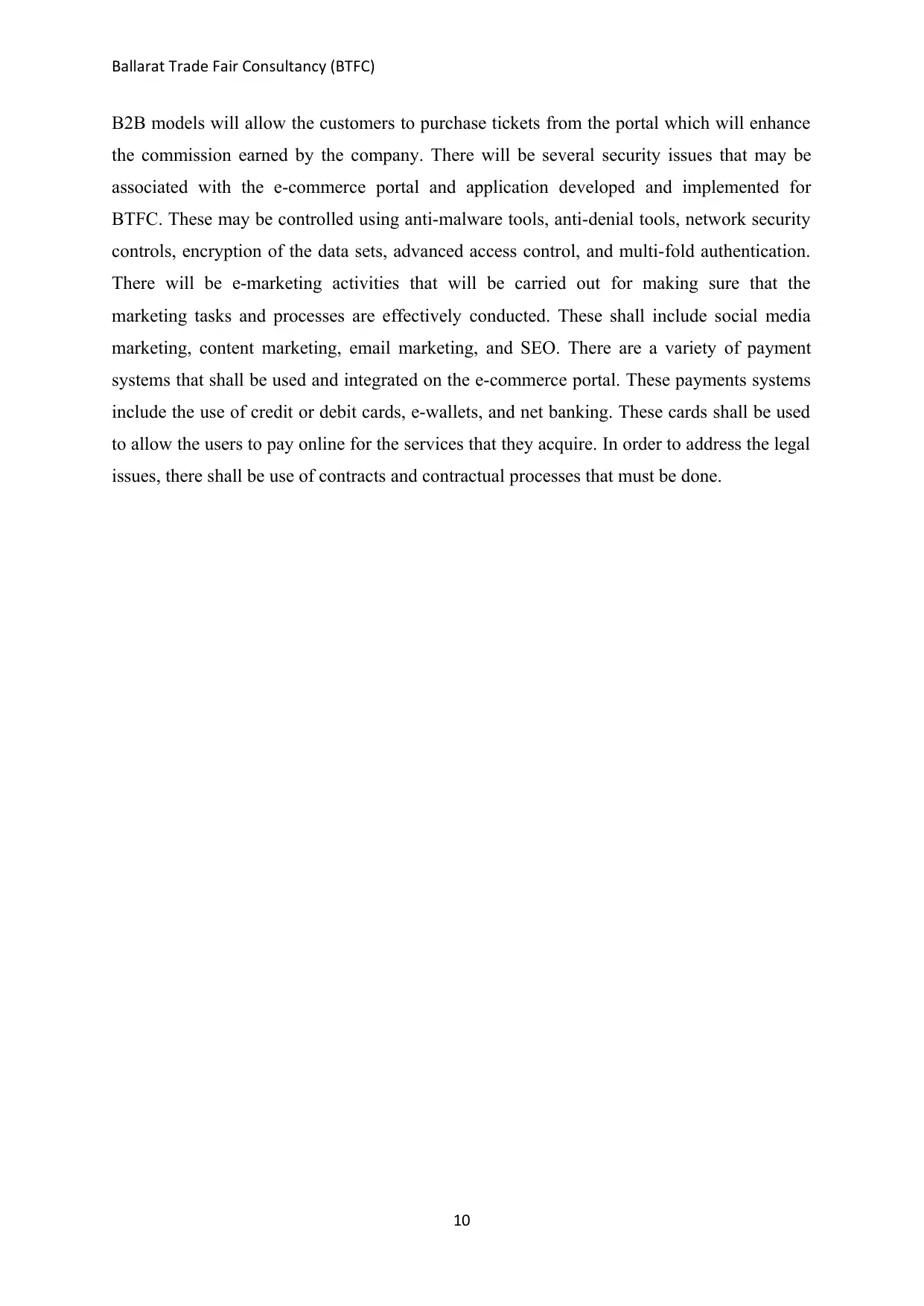
Ballarat Trade Fair Consultancy (BTFC)
B2B models will allow the customers to purchase tickets from the portal which will enhance
the commission earned by the company. There will be several security issues that may be
associated with the e-commerce portal and application developed and implemented for
BTFC. These may be controlled using anti-malware tools, anti-denial tools, network security
controls, encryption of the data sets, advanced access control, and multi-fold authentication.
There will be e-marketing activities that will be carried out for making sure that the
marketing tasks and processes are effectively conducted. These shall include social media
marketing, content marketing, email marketing, and SEO. There are a variety of payment
systems that shall be used and integrated on the e-commerce portal. These payments systems
include the use of credit or debit cards, e-wallets, and net banking. These cards shall be used
to allow the users to pay online for the services that they acquire. In order to address the legal
issues, there shall be use of contracts and contractual processes that must be done.
10
B2B models will allow the customers to purchase tickets from the portal which will enhance
the commission earned by the company. There will be several security issues that may be
associated with the e-commerce portal and application developed and implemented for
BTFC. These may be controlled using anti-malware tools, anti-denial tools, network security
controls, encryption of the data sets, advanced access control, and multi-fold authentication.
There will be e-marketing activities that will be carried out for making sure that the
marketing tasks and processes are effectively conducted. These shall include social media
marketing, content marketing, email marketing, and SEO. There are a variety of payment
systems that shall be used and integrated on the e-commerce portal. These payments systems
include the use of credit or debit cards, e-wallets, and net banking. These cards shall be used
to allow the users to pay online for the services that they acquire. In order to address the legal
issues, there shall be use of contracts and contractual processes that must be done.
10
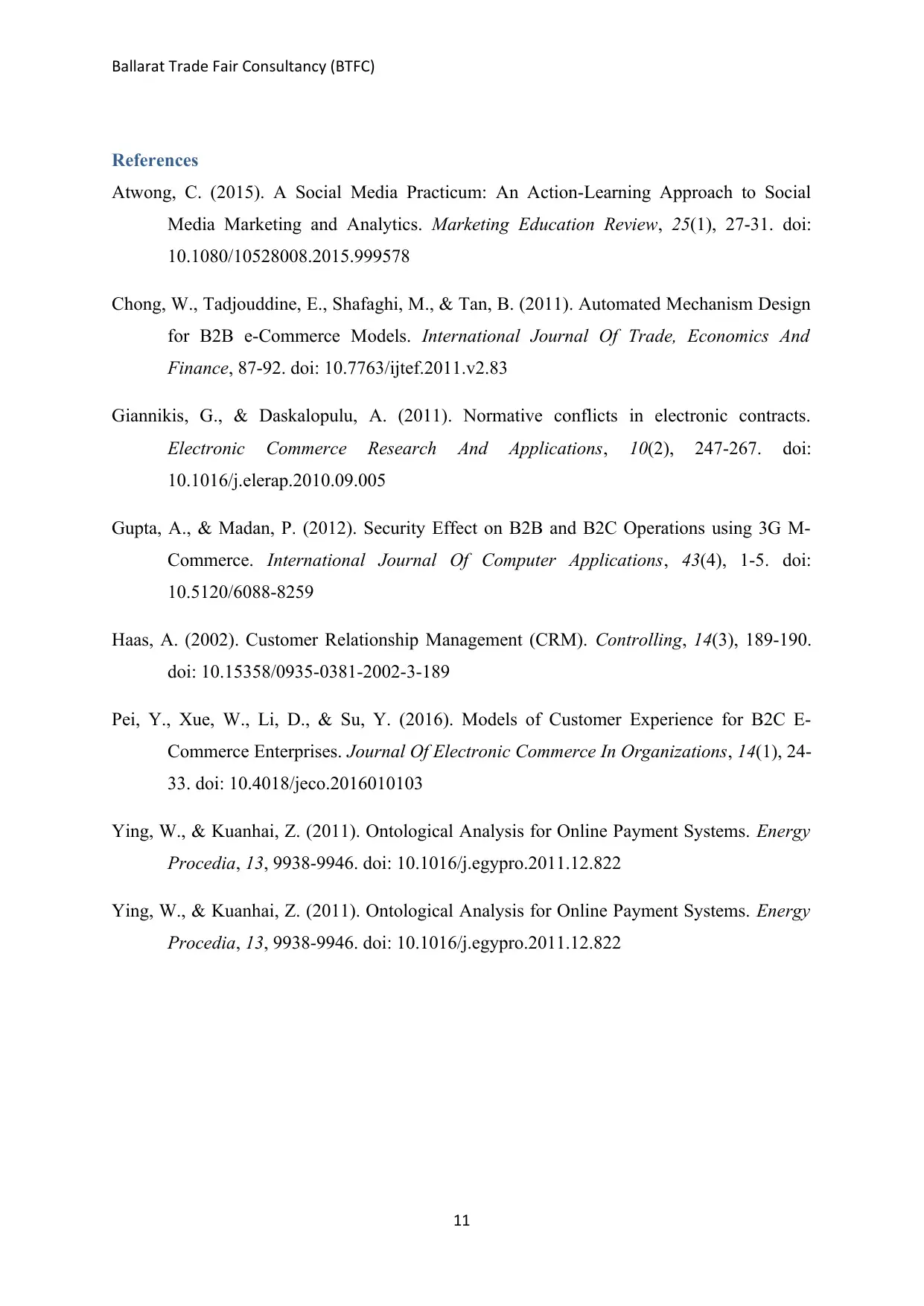
Ballarat Trade Fair Consultancy (BTFC)
References
Atwong, C. (2015). A Social Media Practicum: An Action-Learning Approach to Social
Media Marketing and Analytics. Marketing Education Review, 25(1), 27-31. doi:
10.1080/10528008.2015.999578
Chong, W., Tadjouddine, E., Shafaghi, M., & Tan, B. (2011). Automated Mechanism Design
for B2B e-Commerce Models. International Journal Of Trade, Economics And
Finance, 87-92. doi: 10.7763/ijtef.2011.v2.83
Giannikis, G., & Daskalopulu, A. (2011). Normative conflicts in electronic contracts.
Electronic Commerce Research And Applications, 10(2), 247-267. doi:
10.1016/j.elerap.2010.09.005
Gupta, A., & Madan, P. (2012). Security Effect on B2B and B2C Operations using 3G M-
Commerce. International Journal Of Computer Applications, 43(4), 1-5. doi:
10.5120/6088-8259
Haas, A. (2002). Customer Relationship Management (CRM). Controlling, 14(3), 189-190.
doi: 10.15358/0935-0381-2002-3-189
Pei, Y., Xue, W., Li, D., & Su, Y. (2016). Models of Customer Experience for B2C E-
Commerce Enterprises. Journal Of Electronic Commerce In Organizations, 14(1), 24-
33. doi: 10.4018/jeco.2016010103
Ying, W., & Kuanhai, Z. (2011). Ontological Analysis for Online Payment Systems. Energy
Procedia, 13, 9938-9946. doi: 10.1016/j.egypro.2011.12.822
Ying, W., & Kuanhai, Z. (2011). Ontological Analysis for Online Payment Systems. Energy
Procedia, 13, 9938-9946. doi: 10.1016/j.egypro.2011.12.822
11
References
Atwong, C. (2015). A Social Media Practicum: An Action-Learning Approach to Social
Media Marketing and Analytics. Marketing Education Review, 25(1), 27-31. doi:
10.1080/10528008.2015.999578
Chong, W., Tadjouddine, E., Shafaghi, M., & Tan, B. (2011). Automated Mechanism Design
for B2B e-Commerce Models. International Journal Of Trade, Economics And
Finance, 87-92. doi: 10.7763/ijtef.2011.v2.83
Giannikis, G., & Daskalopulu, A. (2011). Normative conflicts in electronic contracts.
Electronic Commerce Research And Applications, 10(2), 247-267. doi:
10.1016/j.elerap.2010.09.005
Gupta, A., & Madan, P. (2012). Security Effect on B2B and B2C Operations using 3G M-
Commerce. International Journal Of Computer Applications, 43(4), 1-5. doi:
10.5120/6088-8259
Haas, A. (2002). Customer Relationship Management (CRM). Controlling, 14(3), 189-190.
doi: 10.15358/0935-0381-2002-3-189
Pei, Y., Xue, W., Li, D., & Su, Y. (2016). Models of Customer Experience for B2C E-
Commerce Enterprises. Journal Of Electronic Commerce In Organizations, 14(1), 24-
33. doi: 10.4018/jeco.2016010103
Ying, W., & Kuanhai, Z. (2011). Ontological Analysis for Online Payment Systems. Energy
Procedia, 13, 9938-9946. doi: 10.1016/j.egypro.2011.12.822
Ying, W., & Kuanhai, Z. (2011). Ontological Analysis for Online Payment Systems. Energy
Procedia, 13, 9938-9946. doi: 10.1016/j.egypro.2011.12.822
11
1 out of 12
Related Documents
Your All-in-One AI-Powered Toolkit for Academic Success.
+13062052269
info@desklib.com
Available 24*7 on WhatsApp / Email
![[object Object]](/_next/static/media/star-bottom.7253800d.svg)
Unlock your academic potential
© 2024 | Zucol Services PVT LTD | All rights reserved.





